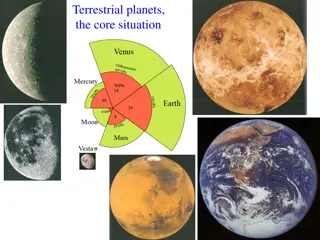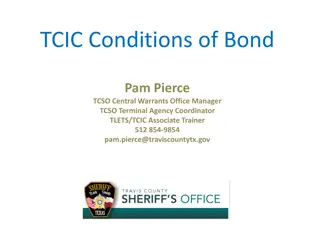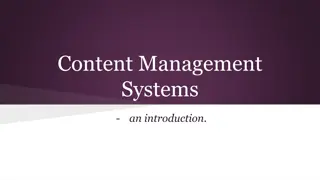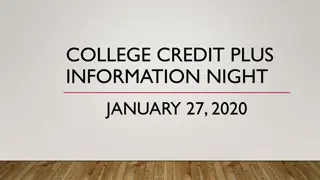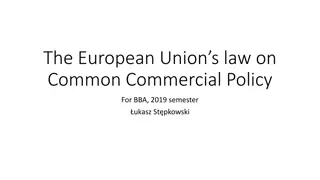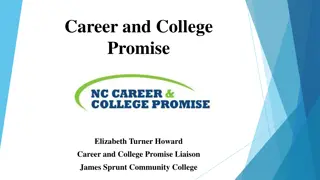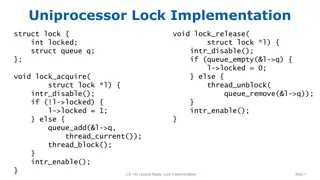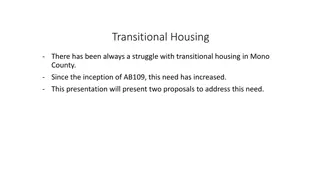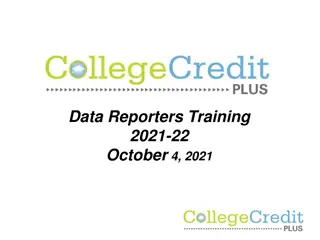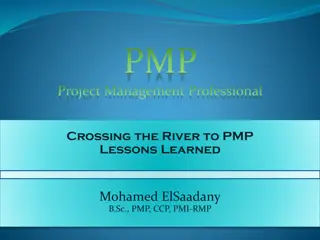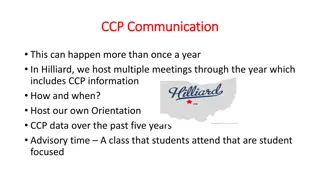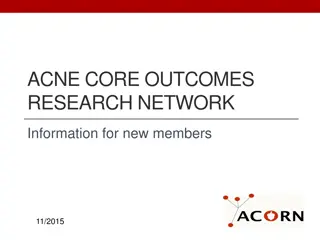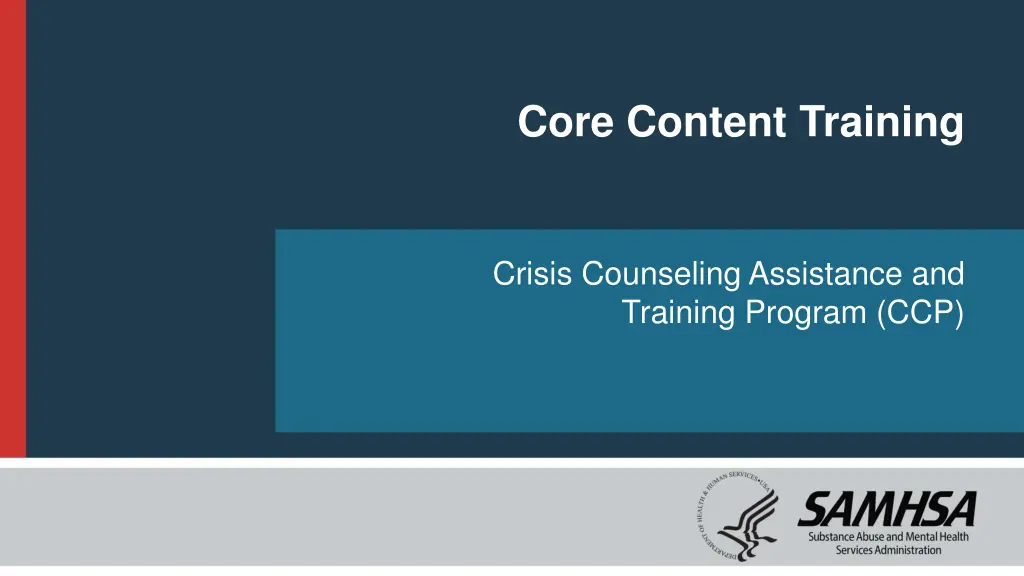
Effective Crisis Counseling and Training Program
"Join the Crisis Counseling Assistance and Training Program (CCP) to learn essential skills for managing crises, disaster responses, and working with special populations. This comprehensive program covers crisis counseling services, disaster reactions, stress management, data collection, and more to equip participants with the necessary tools for helping others in need."
Download Presentation

Please find below an Image/Link to download the presentation.
The content on the website is provided AS IS for your information and personal use only. It may not be sold, licensed, or shared on other websites without obtaining consent from the author. If you encounter any issues during the download, it is possible that the publisher has removed the file from their server.
You are allowed to download the files provided on this website for personal or commercial use, subject to the condition that they are used lawfully. All files are the property of their respective owners.
The content on the website is provided AS IS for your information and personal use only. It may not be sold, licensed, or shared on other websites without obtaining consent from the author.
E N D
Presentation Transcript
Core Content Training Crisis Counseling Assistance and Training Program (CCP)
Opening Activity Take the sheet of paper in front of you and do the following: Fold it as shown on the screen, making a small crease first, and then folding the rest into three equal sections. Do not write anything on the paper. The result should be a tent nametag held in place by the small crease. 2
Opening Activity Write the following information on the three sides of your tent nametag: Your name Your experience with crisis counseling, disaster response, or working with special populations One thing you are hoping to learn about in this course 3
Opening Activity When I say go, introduce yourself to others in the training in the following way: Find someone in the room to introduce yourself to and share the information you wrote down. If there is an odd number of people, form a triad. When I say switch, find someone else to introduce yourself to. When I say switch a third time, find someone else to introduce yourself to, and then stay with that person and await further instructions. 4
Objectives After training, participants will be able to do the following: Describe the range of crisis counseling services. Identify typical disaster reactions. Demonstrate basic crisis counseling skills. Explain the importance of data collection and how to use it. Apply techniques for managing stress. 5
Guidelines for Working Together What thoughts do you have? 6
Guidelines for Working Together Keep time (start on time, return from breaks on time, end on time). Switch mobile phones off or to vibrate. Participate fully. Ask questions freely. Balance talking and listening. Respect each other s point of view. Define an acronym the first time it is used. 7
Course Agenda Day 1 a.m. Welcome and Introductions Course Objectives, Agenda, Norms Disaster Response Overview CCP and Services Day 2 a.m. Survivor Reactions (cont.) Special Populations Interventions and Skills Day 2 p.m. Interventions and Skills (cont.) Survivor Tools Data Collection and Program Evaluation Stress Management Applying Your Learning, Course Evaluation Day 1 p.m. CCP and Services (cont.) Cultural Awareness Survivor Reactions Journal Reflection 8
Section 1Disaster Response Overview Characteristics and Repercussions of a Disaster Federal Emergency Management Agency (FEMA) Disaster Assistance Disaster Response Structure and Operations 9
Session Objectives Describe the key characteristics of this disaster and the impact on survivors. Describe the federal disaster response structure. 10
Characteristics and Repercussions of a Disaster Definition of a Disaster A disaster is a natural or human-caused occurrence (e.g., hurricane, tornado, flood, tsunami, earthquake, explosion, hazardous materials accident, mass criminal victimization incident, war, transportation accident, fire, terrorist attack, famine, epidemic) that causes human suffering. A disaster creates a collective need that overwhelms local resources and requires additional assistance. 11
Characteristics and Repercussions of a Disaster (cont.) Every disaster is different. Disasters affect individuals and the community. Response strategy depends on disaster characteristics. A disaster causes disruptions and changes. 12
Characteristics and Repercussions of a Disaster (cont.) Table Task Take 10 minutes to discuss the following: What are the characteristics of this disaster (e.g., cause, size, scope)? What has been the effect on survivors? Choose a spokesperson to report on your group s discussion. 13
FEMA Disaster Assistance FEMA Disaster Operations Structure 15
FEMA Disaster Assistance (cont.) The Stafford Act establishes the following: All FEMA disaster relief services The intent of Congress The types of federal assistance programs Title 44 of the Code of Federal Regulations does the following: Carries out the intent of the Stafford Act Provides guidance to standardize the implementation of disaster programs The Stafford Act and Title 44 Code of Federal Regulations 16
FEMA Disaster Assistance (cont.) Types of assistance available from FEMA: Hazard Mitigation Public Assistance Individual Assistance (includes the FEMA CCP) 17
FEMA Disaster Assistance (cont.) Individual Assistance (IA) provides help for registered individuals, households, and businesses to include, but not limited to, the following: Temporary housing Loans and Grants Unemployment assistance Crisis counseling Legal Services Disaster Case Management Disaster Supplemental Nutrition Assistance Program Additional information can be found by searching for the FEMA Individual Assistance Program and Policy Guide (IAPPG) 18
FEMA Disaster Assistance (cont.) The Individuals and Households Program (IHP) has two provisions to assist registrants: Housing assistance Other needs assistance 19
FEMA Disaster Assistance (cont.) The IHP also provides Other Needs Assistance (ONA) for registrants. The details of this assistance are as follows: Meets necessary expenses and serious needs Operates within pre-established grant limits Operates under national eligibility criteria Can provide funding for Personal property Transportation Medical, dental, and funeral costs Up to 3 years of flood insurance premiums ONA funding is 75 percent FEMA and 25 percent state/territory/tribal and may be administered by either FEMA or the state, territory, or tribe. Housing is 100 percent federally funded. 20
FEMA Disaster Assistance (cont.) U.S. Small Business Administration Loans Three types of loans exist: Home and personal property Business physical damage Business economic injury Loans are intended to return property to pre-disaster condition. Grants limit assistance to serious needs only. Loans have credit and flood insurance requirements and amount limitations. 21
FEMA Disaster Assistance (cont.) Disaster Unemployment Assistance (DUA) Offers benefits for up to 26 weeks Is available only if the individual has lost work or work is interrupted as a direct result of the disaster Covers those not eligible for regular unemployment benefits Offers reemployment services Is funded by FEMA and administered by the Department of Labor Implemented by the state workforce agency that typically administers regular unemployment insurance 22
FEMA Disaster Assistance (cont.) Other Assistance Disaster Legal Services (DLS) Provided by the Young Lawyers Division of the American Bar Association Offered free of charge to individuals who have insufficient resources to hire an attorney to assist them with their disaster-caused legal needs Disaster Case Management (DCM): DCM is a federally-funded grant program implemented through states, tribes, territories or qualified organizations. DCM provides disaster survivors with a single point of contact to facilitate access to a broad range of resources to meet their disaster caused unmet need in order to recover. 23
FEMA Disaster Assistance (cont.) A Disaster Recovery Center (DRC) is a fixed or mobile provisional facility set up by FEMA in a central location near disaster impacted areas. DRCs are usually opened quickly after a disaster for a limited period of time. The facility offers survivors a one-stop shop to register for FEMA assistance and other disaster related programs and obtain information about disaster relief resources from federal, state, and Indian tribal and non-governmental organizations. 24
FEMA Disaster Assistance (cont.) Disaster Recovery Centers (DRCs) To receive FEMA resources, families need to register. Disaster survivors can register as individuals or heads of households. Local or regional centers provide information to disaster assistance registrants. DRCs may be staffed by crisis counselors, DLS volunteer attorneys, disaster case managers and other federal, state and local agencies providing disaster relief resources. 25
FEMA Disaster Assistance (cont.) The National Processing Service Center 1 800 621 FEMA (3362) Serves as the central facility for gathering and reviewing eligibility for assistance Reviews eligibility for FEMA s Individual and Households Program (IHP) assistance to survivors Provides a toll-free helpline and online service to check the status of applications and obtain information about services: 1-800-621-FEMA (3362) 1 800 462 7585 (TTY for individuals who are deaf or hard of hearing or who have speech disabilities) https://www.disasterassistance.gov 26
FEMA Disaster Assistance (cont.) Emergency Assistance Voluntary organizations active in disaster (VOADs) provide for immediate needs (food, shelter, and clothing). FEMA Voluntary Agency Liaisons (VALs) collaborate with these partners in order to coordinate relief services. 27
FEMA Disaster Assistance (cont.) Crisis Counselor s Role Crisis counselors should be familiar with FEMA, other federal, and state, territory, tribe, or local government recovery programs in order to inform and educate survivors and facilitate appropriate referrals. Survivors may have misconceptions about available assistance from FEMA. Crisis counselors should not join survivors in expressing angry reactions and should not take on the role of advocate for the survivor. The crisis counselor s role is to educate, inform, and support survivors in problem solving, prioritizing needs, and communicating their needs effectively, thus empowering survivors to advocate for themselves. 28
Disaster Response Structure and Operations Entities Eligible To Apply for and Receive CCP Funding States U.S. territories Federally recognized tribes and tribal organizations 29
Disaster Response Structure and Operations (cont.) The CCP consists of two grant types: Immediate Services Program (ISP): 60 days Regular Services Program (RSP): up to 9 months 30
Disaster Response Structure and Operations (cont.) Typical CCP Timeline 31
Disaster Response Structure and Operations (cont.) ISP Accountability Structure 32
Disaster Response Structure and Operations (cont.) RSP Accountability Structure 33
Disaster Response Structure and Operations (cont.) SAMHSA and FEMA Roles and Responsibilities Through an interagency agreement, SAMHSA works with FEMA to implement the CCP. SAMHSA and FEMA collaborate to Provide technical assistance and consultation Administer grants Oversee programs Ensure that grant services are in accordance with the CCP model 34
Disaster Response Structure and Operations (cont.) ISP Organizational Roles and Responsibilities 35
SAMHSA Disaster Technical Assistance Center (DTAC) SAMHSA DTAC supports SAMHSA s efforts to prepare states, territories, tribes, and local entities to deliver effective mental health- and substance use-related responses during disasters. Toll-free: 1 800 308 3515 Email: dtac@samhsa.hhs.gov Web: https://www.samhsa.gov/dtac 36
Section 2CCP and Services Key Concepts Range of Crisis Counseling Services 37
Session Objective Describe the range of crisis counseling services. 38
Mission of the CCP The mission of the CCP is to assist individuals and communities in recovering from the psychological effects of natural and human- caused disasters through the provision of community-based outreach and educational services. 39
Who is Eligible CCP Services are provided at no cost and are available to any survivor, regardless of registering with FEMA, who has been impacted by the disaster. 40
Key Concepts The CCP model is Strengths-based Anonymous Outreach-oriented Culturally aware Conducted in nontraditional settings Designed to strengthen existing community support systems Based on an assumption of natural resilience and competence 41
Key Concepts (cont.) Outreach is Central to the CCP model Guided by initial and ongoing needs assessment A mechanism to find people in need A mode of service delivery 42
Key Concepts (cont.) Traditional Treatment Is office-based May involve diagnosis and treatment of mental illness, as well as identification of strengths and coping skills May focus on longer-term issues Validates experiences associated with distress that has brought the person to treatment Keeps records, charts, case files, etc. Crisis Counseling Is home- and community-based Involves identification of strengths and coping skills Counsels on disaster-related issues Validates common disaster reactions and experiences Does not collect identifying information 43
Range of Crisis Counseling Services Reach of Services 44
Range of Crisis Counseling Services (cont.) Population Exposure Model A. Injured survivors, bereaved family members B. Survivors with high levels of exposure to disaster, or evacuated from disaster zone C. Bereaved extended family and friends, first responders D. People who lost homes, jobs, or possessions; people with preexisting trauma; at-risk groups; disaster behavioral health responders E. Affected people from community at large Adapted from DeWolfe, D. (2002). Mental health interventions following major disasters: A guide for administrators, policy makers, planners, and providers. Rockville, MD: U.S. Department of Health and Human Services, SAMHSA, CMHS. 45
Range of Crisis Counseling Services (cont.) Presentation of this CCP s Needs Assessment and Outreach Strategy. 46
Range of Crisis Counseling Services (cont.) Table Activity: Needs Assessment and Outreach Strategy Step 1 Needs Assessment Take 15 minutes to complete the following: Identify the geographic areas affected in the disaster. Identify populations (or groups) that are affected by this disaster. Identify the priority needs in the affected communities (e.g., rebuilding/repairing homes, clothing, treatment). Make notes in your workbook. Choose a spokesperson to report on your group s discussion. 47
Range of Crisis Counseling Services (cont.) Table Activity: Needs Assessment and Outreach Strategy (cont.) Step 2 Resource Identification Take 15 minutes to discuss the following: For the priority needs selected, identify community resources that would meet those needs (e.g., community organizations such as faith-based organizations, disaster assistance organizations, schools). Make notes in your workbook. Choose a spokesperson to report on your group s discussion. 48
Range of Crisis Counseling Services (cont.) Table Activity: Needs Assessment and Outreach Strategy (cont.) Step 3 Outreach Strategy Take 15 minutes to complete the following: Identify the key actions this program should take to conduct successful outreach to survivors. Identify key actions you can take to conduct outreach to organizations that have resources available for survivors. Make notes in your workbook. Choose a spokesperson to report on your group s discussion. 49
Range of Crisis Counseling Services (cont.) Individual and Family Crisis Counseling Encounters video 50

